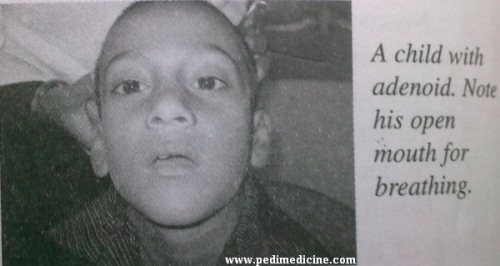What is adenoid:
At the junction of the roof and posterior wall of the nasopharynx there are some aggregated collection of Lymph node, known as Waldeyers ring. Adenoids or the Nasopharyngeal tonsil is part of them. In my previous post I show you the Juvenile Nasopharyngeal tumour. Today I am going to introduce with you the Enlarged Adenoid. Usually it is a protective part of our body system. But an Hypertrophy of the nasopharyngeal tonsils sufficient to produce symptoms most commonly between 3 to 8 years old is known as Enlarged Adenoid. Enlarged adenoids in young children are one of the most common causes of nasal obstruction
Most of the people know the Tonsils, but the difference is that it does not have any capsules or crypts. it is present at birth and attains its maximum size between the age of 3 to 8 years and then regress. The most important function of Adenoids are Production of Antibodies eg. IgA, IgM, and IgG.
Why It Enlarges?
Adenoid hyperplasia with enlargement and multiplication of the lymphoid follicles may occur from-
- Physiological enlargement in childhood due to exposure to multiple antigens.
- Acute bacterial or viral adenitis.
- Recurrent attacks of rhinitis, sinusitis or tonsillitis.
- Allergy of the upper respiratory tract.

Clinical features:
It depends upon the relative size of the adenoids in relation to the actual nasopharyngeal space rather than the absolute size of the adenoids.
Nasal Symptoms:
- Nasal obstruction
- Breathing through mouth.
- Snoring.
- Obstructive sleep apnea.
- Hyponasal speech
- Nasal discharge.
- Post nasal drip.
Ear Symptoms due to blocking Eustachian Tube
- Pain in the ear.
- Recurrent attack of acute otitis media.
- Otitis media with effusion.
- Conductive deafness.
- There may be retracted ear drum formation.
General Features:
Adenoid facies is the typical appearance of a child which comprises of following-
- Pinched nostrils.
- High arched palate.
- Depressed nasolabial furrow.
- prominent and crowded upper incisor teeth.
- Open mouth.
- Long face
- Dull apathetic look.
- Short upper lip, larger lower lip.
How to Diagnose a Adenoid case?
Diagnosis is mainly done from History and clinical features. Age is suggestive and valuable for diagnosis. Some investigations is needed to confirm your diagnosis.
X-ray soft tissue nasopharynx lateral view is the most important among the investigations. It shows adenoid hypertrophy with compromised nasopharyngeal airway. Sometimes it may get confused with Antrochoanal polyp. How to differentiate it from then? The answer is easy. Air column will be anterior or infront to the mass in case of Adenoid hypertrophy. But in Antrochoanal polyp it will be posterior or behind.

A flexible or rigid nasopharyngoscope is also helpful. Post nasal space examination can be done also. But usually not necessary. Other investigations are for anesthesia and operations.
Treatment:
Treatment protocol depends upon the size of the adenoid, patients wishes and symptoms. If symptoms are mild and patient does not a hazard of operation then conservative treatment can be helpful.
Conservative treatment consists of
- Nasal Decongestants drop.
- Systemic antihistamine.
- Systemic broad spectrum antibiotic.
- Nasal breathing exercise.
- And above all, Nutritional diet.
But if symptoms are marked and hampered day to day life then you must consider the Adenoidectomy under general anesthesia. Tonsillectomy is routinely done along with adenoidectomy in most children aged above 3 years for sleep apnea or snoring.
A child with adenoids and otitis media with effusion causing conductive deafness needs Myringtomy and grommet insertion.
Methods of Adenoidectomy:
- Curettage method – mostly done.
- LASER.
- Coblation assisted adenoidectomy (minimum bleeding)
When Adenoidectomy can not be done?
- Recent upper respiratory tract infection.
- Uncontrolled bleeding disorder.
- Cleft palate or submucosal cleft palate.
Thanks.


Dear Doctor,
I have done my 6 years old sons XR Nasopharynx and got the following result:
Hypertrophied posterior nasopharyngeal soft tissue indenting the nasopharyneal air column likely representing enlarged adenoid.
The imaged part of the skeleton is normal in appearance.
Doctor, i am worried about it, can you please explain me more about it means treatment or to dos and donts for my son.
Thanks in advance.
If enlarged adenoid produces symptoms described above you should consult with your doctor soon. The Doctor will decide if your child needs conservative treatment or surgery. Thanks. Can you please provide me the x-ray photo?
My mothervis suffering from joint pain for many years all test investigAtion are normal only CRP and Aso titre are rsised i consultva physician but he take it lightly that it is due to joint pain or any other infection and there is no treatment of Aso and Crp plz gave ur sugestion
Please Brain MRI done for 18year old girl with incidental finding of enlarged adenoid in the nasopharynx and a tiny Thornwaldt cyst noted please explain thanks
could u mention about metaspray indications ?
metaspray is indicated for the treatment of the nasal symptoms of seasonal and perennial allergic rhinitis, in adults and pediatric patients 2 years of age and older, For the prophylaxis of the nasal symptoms of seasonal allergic rhinitis in adult and adolescent patients 12 years and older. Also indicated for the treatment of nasal polyps in patients 18 years and older. It is a corticosteroid having anti inflammatory properties.
Thank you for your attention. I am really grateful to you. The X ray picture here is taken as Photographs from a Book. As you are a Clinician can you provide a Right X ray picture? I will add that with your reference. Thanks again.